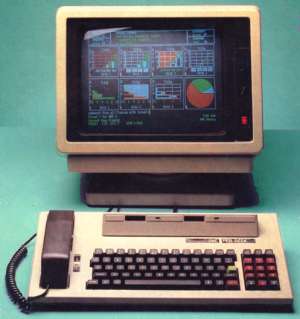
|
Manufacturer |
ICL (International Computers Ltd) (UK)
The design was a collaboration by ICL, Sinclair and British Telecom. |
Model |
OPD (One Per Desk)
Also marketed by British Telecom as the Merlin M1800 Tonto and by Telecom Australia as the Computerphone. |
Date Launched |
Late 1984 |
Price |
£1320 with monochrome monitor |
Microprocessor type |
Motorola 68008 @ 7.5MHz
A second processor, an 8051, controlled the modem and keyboard. |
ROM size |
128 kilobytes for operating system |
Standard RAM |
128 kilobytes
( + 2KB battery-backed CMOS) |
Maximum RAM |
256 kilobytes |
Keyboard type |
Typewriter style, separate keys pressing on a rubber membrane, with a numeric pad laid out like a telephone keypad. |
Supplied language |
ICL-Basic which was loaded from microdrive and was a subset of SuperBasic as supplied with the Sinclair QL.
The operating system was called Base Functional Software. |
Text resolution |
40 x 26 or 80 x 26 characters.
Bottom 2 lines were a status display. |
Graphics resolution |
512 x 256 or 256 x 256 pixels |
Colours available |
4 (black, white, red, green) in high resolution.
8 (black, white, red, green, blue, purple, cyan, yellow) plus flashing in low resolution. |
Sound |
An internal speaker which could be used as a loudspeaker for the telephone |
Cassette load speed |
No cassette interface.
Had two microdrives built into the top of the console. These were similar to those designed by Sinclair and fitted to the QL but modified by ICL to improve reliability. Capacity was approximately 95 kilobytes per cartridge. |
Dimensions (mm)
Weight (grams) |
440 x 250 x 95
3000 (figures for keyboard/telephone console only) |
Special features |
Included a telephone on the left side of the console and an internal modem operating at up to 1200 baud.
Had a Texas Instruments TMP5220C speech synthesizer chip, with a vocabulary of 152 words, which could be set to speak a message to callers if the telephone was not answered.
A messaging module allowed electronic mail to be sent between OPDs over the telephone line. |
Good points |
Could hold up to 350KB of application software in plug-in ROM capsules, providing almost instant access to common programs.
The operating system was multitasking, or more precisely it allowed rapid task switching.
The OPD was generally supplied with the highly regarded PSION Xchange software suite comprising a word processor, database, spreadsheet and business graphics, all on ROM cartridges. |
Bad points |
The microdrives were slow and not fully reliable.
The various functions of the OPD were not properly integrated. For example, it was not possible to send a document directly from the word processor to the modem as electronic mail; it had to be saved to microdrive first then a different program used to send it.
The maximum of 256KB of RAM was somewhat low for a multitasking operating system (without virtual memory) and limited the number of concurrent applications.
The serial port could only transmit so it was not possible to network an OPD to another computer except by using the modem and telephone line.
Probably the greatest weakness of the One Per Desk was that it was not compatible with any other computer, not even the QL. |
How successful? |
Despite mostly favourable reviews in the computer Press the One-Per-Desk managed only modest sales of a few thousand units over a three year period, most going to government departments or large companies. Apparently the OPD was popular with those who used it. |
Comments |
The One-Per-Desk was based on the electronics of the Sinclair QL and was designed as a do-it-all basic computing and communications device, with an emphasis on machine to machine transfer of data over the telephone system. Software was provided to access the Prestel Viewdata database and for terminal emulation for connection to remote databases. The OPD was a unique and farsighted design at the time. It's nearest equivalent today would be a SmartPhone with email and internet access.
The OPD was supplied with either a 9 inch monochrome monitor or the 14 inch colour monitor pictured above.
The One Per Desk was designed to present a simple interface to the user. Hence DOS or CP/M operating systems with their cryptic commands were considered unsuitable and ICL produced their own menu-driven OS.
The computer was designed to run continuously, with programs stored in ROM and data held in the RAM, rather than being constantly saved to disk as in a modern PC.
Use of the Sinclair microdrives was probably a mistake. Even though ICL had improved the design somewhat they were slow, typically taking over a minute to save a document, and of uncertain reliability. The OPD had a utility which attempted to predict the remaining life of a microdrive cartridge, initially set at 20 hours use, which demonstrates ICL's doubts about their use. It would have been better to fit a single 3½ inch standard floppy disk drive which would have also allowed data to be exchanged with other systems more easily. |

